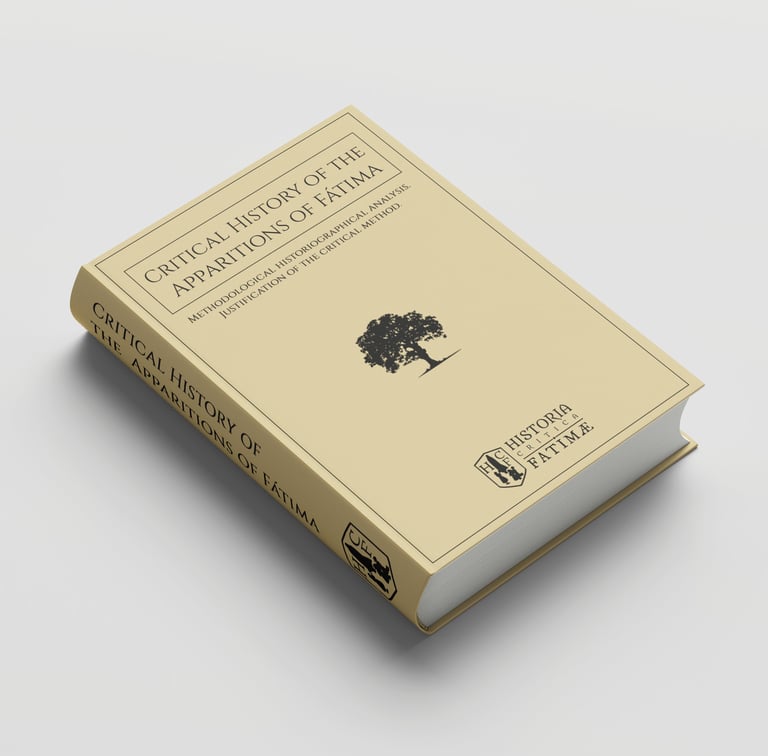Architecture of the Corpus Historicum Fatimae Criticum
The Corpus examines the Apparitions of Fátima in their full dimension, leaving no essential aspect unexplored. Our work moves from the personal stories of the seers to the documentary trail, from the art it inspired to the political and cultural debates it ignited. This monumental task finds its structure in a carefully sequenced publication plan of twenty volumes.
This architecture is designed to guide the reader through a complete and critical reconstruction of the entire Fátima phenomenon.
The doctoral thesis of Dr. Álvaro Albornoz Castro (2024) constitutes the basis of this editorial plan and validates its feasibility.
Note: this architecture is not definitive and may be modified according to the needs of the research.
List of Volumes of the Corpus Historicum Fatimae Criticum
Critical History of the Apparitions of Fátima.
Methodological historiographical analysis. Justification of the critical method.Critical History of the Apparitions of Fátima I. May
Historical-critical reconstruction of the first apparition of May 13, 1917, based on the collation and diachronic analysis of the foundational testimonies. Critical examination.Critical History of the Apparitions of Fátima II. June
Historical-critical reconstruction of the second apparition of June 13, 1917, based on the collation and diachronic analysis of the foundational testimonies.Critical History of the Apparitions of Fátima III. July
Historical-critical reconstruction of the third apparition of July 13, 1917, based on the collation and diachronic analysis of the foundational testimonies.Critical History of the Apparitions of Fátima IV. August
Historical-critical reconstruction of the events of August 13, 1917, based on the collation and diachronic analysis of the testimonies. Critical study of the episode of the detainment of the visionaries and the subsequent Apparition at Valinhos.Critical History of the Apparitions of Fátima V. September
Historical-critical reconstruction of the fifth apparition of September 13, 1917, based on the collation and diachronic analysis of the foundational testimonies.Critical History of the Apparitions of Fátima VI. October. Our Lady of the Rosary
Historical-critical reconstruction of the sixth apparition of October 13, 1917, based on the collation and diachronic analysis of the foundational testimonies.Critical History of the Apparitions of Fátima VII. The Miracle of the Sun
Comprehensive critical analysis of the solar phenomenon of October 13, 1917, examining and presenting a list of eyewitness testimonies, press reports, and explanatory hypotheses given throughout historiography. Comprehensive analysis of the "Miracle of the Sun" and the constitution of collective testimony from contemporary primary sources.Critical History of the Apparitions of Fátima VIII. Miracles and Cures
Critical evaluation of accounts of cures and miraculous phenomena occurring in Fátima both in 1917 and other periods, contrasting testimonies and detailing each case of cures, along with the medical opinion of the time (where applicable) and the treatment in the press.Critical History of the Apparitions of Fátima IX. The Three Parts of the Secret
Critical historiography of the composition, transmission, and progressive reception of the message known as the "secret of Fátima" in its three parts, with new documentary contributions.Critical History of the Apparitions of Fátima X. Biography of Sister Lúcia I
Critical biographical reconstruction of Lúcia de Jesus Rosa dos Santos, from 1921 to 1957 (with a brief section on her childhood).Critical History of the Apparitions of Fátima XI. Biography of Sister Lúcia II. Documents
Critical edition, commentary, and analysis of the interrogations, autograph writings, epistolary records, and memoirs of Sister Lúcia.Critical History of the Apparitions of Fátima XII. Biography of Sister Lúcia III. Studia Luciana
Critical studies on biographical, historical, spiritual, and polemical themes related to Lúcia de Jesus Rosa dos Santos.Critical History of the Apparitions of Fátima XIII. Biography of Jacinta Marto
Reconstruction and historical-critical analysis of the figure of Jacinta Marto according to testimonies, examining her role in the events and her subsequent devotional representation.Critical History of the Apparitions of Fátima XIV. Biography of Francisco Marto
Reconstruction and historical-critical analysis of the figure of Francisco Marto according to testimonies, examining his role in the events and his subsequent devotional representation.Critical History of the Apparitions of Fátima XV. History of the literature on Fátima
Critical-historiographical study of the source works related to Fátima (1917-present), evaluating their influence and documentary reliability.Critical History of the Apparitions of Fátima XVI. Image of Our Lady of the Rosary
Critical analysis of the mariophanic description according to the accounts of the three visionaries at different stages, and its materialization in the first iconographic representations. Includes an image of the historical reconstruction performed according to the numerous testimonies of the visionaries.Critical History of the Apparitions of Fátima XVII. Art and Iconography
Critical study of the development of iconography, artistic production, and aesthetic evolution surrounding Fátima during the 20th and 21st centuries.Critical History of the Apparitions of Fátima XVIII. Political Reception
Examination of the reception of the Fátima message in the sphere of Portuguese politics and the international geopolitical context.Critical History of the Apparitions of Fátima XIX. Evolution of the Message of Fátima
Critical study of the evolution and consequent theological transformation of the message of Fátima and the consolidation of its narrative core from the first half of the 20th century to the beginning of the 21st century. The message of Fátima, between Catholic orthodoxy and impossibility in the new conciliar theology.


info@historiacritica.com
+ 40 784 812 387
Copyright © 2025. Historia Critica Fatimae - All rights reserved.


CONTACT
SHARE
FOLLOW
